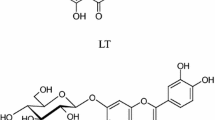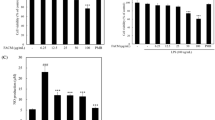Abstract
Cyanidin-3-glucoside (C3G) and cyanidin-3-rutinoside (C3R) are 2 major anthocyanins found in Korean Rubus fruits (blackberries, raspberries, and black raspberries). The antioxidant and antiinflammatory effects of C3G and C3R in RAW264.7 murine macrophage cells were determined. Anthocyanins (5, 10, and 20 μg/mL) significantly (p<0.05) reduced H2O2-induced cytotoxicity in H2O2-stimulated RAW264.7 cells, compared with control cells. Incubation with C3G or C3R significantly (p<0.05) decreased intracellular reactive oxygen species and DNA damage (Hoechst and comet assay), and the cellular ferric reducing antioxidant power also increased, compared with control cells. Nitric oxide production in LPS-stimulated RAW264.7 cells treated with C3G and C3R was reduced by 41.9 and 34.4%, respectively. In addition, LPS-induced prostaglandin E2 production was significantly (p<0.05) inhibited by C3G (51.7%) and C3R (58.6%), compared with LPS-stimulated control cells. Protein expressions of iNOS and COX-2 decreased in cells treated with anthocyanins. Anthocyanins down-regulated NF-κB expression and up-regulated I-κB expression in LPS-treated macrophages.
Similar content being viewed by others
References
Jeong JH, Jung H, Lee SR, Lee HJ, Hwang KT, Kim TY. Antioxidant, anti-proliferative, and anti-inflammatory activities of the extracts from black raspberry fruits and wine. Food Chem. 123: 338–344 (2010)
Jung J, Son MY, Jung S, Nam P, JS Sung, Lee SJ, Lee KG. Antioxidant properties of Korean black raspberry wines and their apoptotic effects on cancer cells. J. Sci. Food Agr. 89: 970–977 (2009)
Riceevans CA, Miller NJ, Bolwell GP, Bramley PM, Pridham JB. The relative antioxidant activities of plant-derived polyphenolic flavonoids. Free Radic. Res. 22: 375–383 (1995)
Ju HK, Cho EJ, Jang MH, Lee YY, Hong SS, Park JH, Kwon SW. Characterization of increased phenolic compounds from fermented Bokbunja (Rubus coreanus Miq.) and related antioxidant activity. J. Pharm. Biomed. Anal. 49: 820–827 (2009)
Pergola C, Rossi A, Dugo P, Cuzzocrea S, Sautebin L. Inhibition of nitric oxide biosynthesis by anthocyanin fraction of blackberry extract. Nitric Oxide. 15: 30–39 (2006)
Tulio Jr AZ, Reese RN, Wyzgoski FJ, Rinaldi PL, Fu R, Scheerens JC, Miller AR. Cyanidin 3-rutinoside and cyanidin 3-xylosylrutinoside as primary phenolic antioxidants in black raspberry. J. Agr. Food Chem. 56: 1880–1888 (2008)
Miyazawa T, Nakagawa K, Kudo M, Muraishi K, Someya K. Direct intestinal absorption of red fruit anthocyanins, cyanidin-3-glucoside and cyanidin-3,5-diglucoside, into rats and humans. J. Agr. Food Chem. 47: 1083–1091 (1999)
Jacob RA, Burri BJ. Oxidative damage and defense. Am. J. Clin. Nutr. 63: 985S–990S (1996)
Thannickal VJ, Fanburg BL. Reactive oxygen species in cell signaling. Am. J. Physiol. Lung Cell Mol. Physiol. 279: L1005–L1028 (2000)
Wang H, Nair MG, Strasburg GM, Chang Y-C, Booren AM, Gray JI, DeWitt DL. Antioxidant and antiinflammatory activities of anthocyanins and their aglycon, cyanidin, from tart cherries. J. Nat. Prod. 62: 294–296 (1999)
Im S-E, Nam T-G, Lee H, Han M-W, Heo HJ, Koo SI, Lee CY, Kim D-O. Anthocyanins in the ripe fruits of Rubus coreanus Miquel and their protective effect on neuronal PC-12 cells. Food Chem. 139: 604–610 (2013)
Kang TH, Hur JY, Kim HB, Ryu JH, Kim SY. Neuroprotective effects of the cyanidin-3-O-β-d-glucopyranoside isolated from mulberry fruit against cerebral ischemia. Neurosci. Lett. 391: 122–126 (2006)
Feng R, Ni H-M, Wang SY, Tourkova IL, Shurin MR, Harada H, Yin X-M. Cyanidin-3-rutinoside, a natural polyphenol antioxidant, selectively kills leukemic cells by induction of oxidative stress. J. Biol. Chem. 282: 13468–13476 (2007)
Scuro LS, Simioni P, Grabriel D, Saviani EE, Modolo LV, Tamashiro WMSC, Salgado I. Suppression of nitric oxide production in mouse macrophages by soybean flavonoids accumulated in response to nitroprusside and fungal elicitation. BMC Biochem. 5: 1–8 (2004)
Kim MJ, Choung S-Y. Mixture of polyphenols and anthocyanins from Vaccinium uliginosum L. alleviates DNCB-induced atopic dermatitis in NC/Nga mice. J. Evid. Based Complem. Altern. Med. 2012: (2012)
Nizamutdinova IT, Kim YM, Chung JI, Shin SC, Jeong Y-K, Seo HG, Lee JH, Chang KC, Kim HJ. Anthocyanins from black soybean seed coats preferentially inhibit TNF-α-mediated induction of VCAM-1 over ICAM-1 through the regulation of GATAs and IRF-1. J. Agr. Food Chem. 57: 7324–7330 (2009)
Tak PP, Firestein GS. NF-kappa B: A key role in inflammatory diseases. J. Clin. Invest. 107: 7–11 (2001)
Gloire G, Legrand-Poels S, Piette J. NF-κB activation by reactive oxygen species: Fifteen years later. Biochem. Pharmacol. 72: 1493–1505 (2006)
Izumi S, Ohno N, Yadomae T. Down-regulation of LPS-induced nitric oxide synthesis of murine macrophages by oral administration of Sho-saiko-to. Drug Dev. Res. 40: 48–55 (1997)
Mosmann T. Rapid colorimetric assay for cellular growth and survival: Application to proliferation and cytotoxicity assays. J. Immunol. Methods 65: 55–63 (1983)
Benzie IF, Strain J. The ferric reducing ability of plasma (FRAP) as a measure of “antioxidant power”: The FRAP assay. Anal. Biochem. 239: 70–76 (1996)
Kang Y, Park Y, Lee G. The nitrite scavenging and electron donating ability of phenolic compounds. Food Sci. Biotechnol. 28: 232–239 (1996)
Rahman MM, Ichiyanagi T, Komiyama T, Hatano Y, Konishi T. Superoxide radical-and peroxynitrite-scavenging activity of anthocyanins; structure-activity relationship and their synergism. Free Radic. Res. 40: 993–1002 (2006)
Lai Y-S, Hsu W-H, Huang J-J, Wu S-C. Antioxidant and antiinflammatory effects of pigeon pea (Cajanus cajan L.) extracts on hydrogen peroxide-and lipopolysaccharide-treated RAW264. 7 macrophages. Food Funct. 3: 1294–1301 (2012)
Pool-Zobel B, Bub A, Schröder N, Rechkemmer G. Anthocyanins are potent antioxidants in model systems but do not reduce endogenous oxidative DNA damage in human colon cells. Eur. J. Nutr. 38: 227–234 (1999)
Hou DX, Fujii M, Terahara N, Yoshimoto M. Molecular mechanisms behind the chemopreventive effects of anthocyanidins. J. Biomed. Biotechnol. 2004: 321–325 (2004)
Seeram N, Momin R, Nair M, Bourquin L. Cyclooxygenase inhibitory and antioxidant cyanidin glycosides in cherries and berries. Phytomedicine 8: 362–369 (2001)
Hou D-X, Yanagita T, Uto T, Masuzaki S, Fujii M. Anthocyanidins inhibit cyclooxygenase-2 expression in LPS-evoked macrophages: Structure-activity relationship and molecular mechanisms involved. Biochem. Pharmacol. 70: 417–425 (2005)
Wang Q, Han PH, Zhang MW, Xia M, Zhu HL, Ma J, Hou MJ, Tang ZH, Ling WH. Supplementation of black rice pigment fraction improves antioxidant and anti-inflammatory status in patients with coronary heart disease. Asia Pac. J. Clin. Nutr. 16: 295–301 (2007)
Xia M, Ling W, Zhu H, Ma J, Wang Q, Hou M, Tang Z, Guo H, Liu C, Ye Q. Anthocyanin attenuates CD40-mediated endothelial cell activation and apoptosis by inhibiting CD40-induced MAPK activation. Atherosclerosis 202: 41–47 (2009)
Jin X-H, Ohgami K, Shiratori K, Suzuki Y, Koyama Y, Yoshida K, Ilieva I, Tanaka T, Onoe K, Ohno S. Effects of blue honeysuckle (Lonicera caerulea L.) extract on lipopolysaccharide-induced inflammation in vitro and in vivo. Exp. Eye Res. 82: 860–867 (2006)
Author information
Authors and Affiliations
Corresponding author
Rights and permissions
About this article
Cite this article
Jung, H., Kwak, HK. & Hwang, K.T. Antioxidant and antiinflammatory activities of cyanidin-3-glucoside and cyanidin-3-rutinoside in hydrogen peroxide and lipopolysaccharide-treated RAW264.7 cells. Food Sci Biotechnol 23, 2053–2062 (2014). https://doi.org/10.1007/s10068-014-0279-x
Received:
Revised:
Accepted:
Published:
Issue Date:
DOI: https://doi.org/10.1007/s10068-014-0279-x




